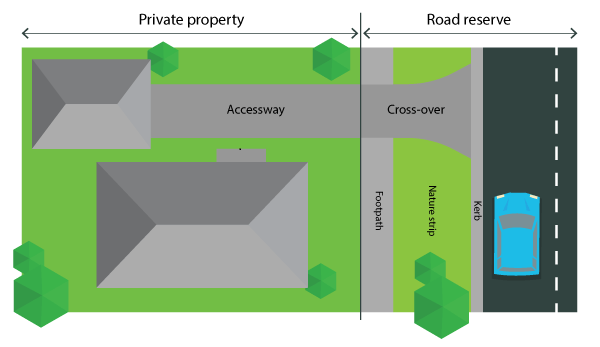You can use our planning process glossary to help explain any technical terms included on this page.
Design standards and guideline drawings for crossovers can be found on our Technical drawings for roadworks page(opens in a new window).
What a crossover is
A crossover is the connection of an accessway/driveway, from the edge of the property to the road, which often crosses a footpath, nature strip, or kerb.
A crossover allows vehicles to move between the property and the road.
Crossovers are the pathway constructed within the road reserve to enable access from a property onto the road.
Differences between an accessway and a crossover
An accessway relates to:
- the path used to approach the road from within a property
- what is happening within the site only, not on the road reserve.
An accessway is also often referred to as a driveway. The image below outlines the difference between an accessway and a crossover.

New crossovers and your property
If you are seeking a new access (or changes to an existing access) from your property onto the Department of Transport and Planning’s arterial road network, a council planning permit is required.
The application will be referred to the Department of Transport and Planning for assessment under Clause 52.29 of the Victoria Planning Provisions(opens in a new window).
Once a planning permit has been issued by the responsible authority, a vehicle crossing permit and/or road opening permit will still be required from your local council for the works to be undertaken.
In addition, on a Department of Transport and Planning arterial road, there may be additional requirements or approvals under the Road Management Act 2004(opens in a new window) for any works to be undertaken within the road reserve. It is important to always check with the Department of Transport and Planning if there are any other requirements that need to be met, even if planning approval for access has been granted.
Considerations for new access
When assessing applications for new access, the Department of Transport and Planning will consider factors such as:
- how vehicles enter and exit the road - i.e. driving forward and not reversing into traffic
- the proposed crossover design - including location, width, angle, and line of sight
- types of vehicles and traffic generated by the proposal – i.e. trucks or delivery vehicles, cars, motorcycles, and bicycles (as well as the number of these vehicles at different times)
- existing road conditions - including traffic volume, speed, and existing infrastructure (traffic lights, clearways, pedestrian crossings, and tram or bus stops)
- any work that might be required by the site developer to make sure the crossover and road network operate safely - including the provision of slip lanes, traffic islands, traffic signals, etc.
The Department of Transport and Planning may impose conditions on a planning permit to ensure the arterial road network continues to operate in an efficient and safe manner.
Design standards for rural crossovers are available on our Standard drawings for roadworks page(opens in a new window) under Access & stopping bays.
Constructing a new crossover or removing an existing crossover
Under section 63 (1) of the Road Management Act(opens in a new window), a person must not conduct any work in, on, under, or over a road without the written consent of the coordinating road authority.
Any works on a road corridor generally need permission from the road manager. For arterial roads, the road manager is The Department of Transport and Planning
However, there are exemptions in the Road Management (Works and Infrastructure) Regulations 2015(opens in a new window) where crossovers may be exempt from the requirement to obtain a consent for works (if the works are not traffic impact works).
For more information on this topic, you can visit our Working within the road reserve page(opens in a new window) or contact us.
Conditions the Department of Transport and Planning may impose
All applications are individually assessed taking into consideration the site and the surrounding road network, as set out above.
Depending on the size of the development proposed, the Department of Transport and Planning may also require additional works within the road reserve.
The Department of Transport and Planning usually requires that vehicles enter and exit a property driving forward (not reversing). Other conditions may be set out, related to any aspect of the proposal, to ensure the safe and efficient operation of the arterial road network.
Traffic management plans
Even if consent for works is not required, all works in the road reserve are required to be done safely. This means that the preparation of a traffic management plan as per section 99A of the Road Safety Act(opens in a new window) is necessary.
There must always be a copy of the traffic management plan on site when workers are present.
The traffic management plan is required to ensure that your work is conducted in a manner that is safe for road users and workers on the road.
More information and guidance on traffic management plans are available on our Working within the road reserve page(opens in a new window).
Updated